
習作としての桂花の太肉麺クローン作り A study on cloning Keika's Taaroo noodles
中華乾麺千本ノック 1000 fungos for Chinese dried noodles
ストーリー
Recipe trivia
「桂花ラーメン」をご存知だろうか?
「熊本ラーメン」の先駆けになったラーメン店の一つだ。設備投資に失敗して2000年に会社更生法の適用を受けたが、この店の初代の調理人で理解者であった味千グループの社長が救済の手を差し伸べ、味やシステムを変えることなく、今も存続している。本家の熊本市内(熊本の郊外にはない)と首都圏以外の人は知らない人も多いかもしれないが、チェーン展開の三店舗目が新宿という、ラーメンブームを見越したような、先見的な展開をしていた。当時首都圏には、今のようなご当地ラーメンやニューウェーブのラーメンは、サッポロラーメン以外はほぼ存在せず、支那そばや町中華全盛の時代。この桂花ラーメンの東京進出はかなり野心的だったことがわかる。僕も学生時代に、末広亭の前にあるこの店舗に通った。僕はラーメンは大好きだけど、特定のラーメンに「嵌まる」という事はほとんどない。この桂花ラーメンの「太肉(ターロー)」麺」と「阿蘇ラーメン」は、かなりの例外だ。新宿でのアルバイトの帰りに、かなり頻繁に通っていた。通り道にあるからではなく、わざわざ食べに行くのだ。だから、倒産騒ぎを聞きつけた時は悲しかった。存続が決まって、めでたしめでたしだった。
倒産騒ぎの時は、僕の本業はコンピュータのエンジニアで、料理の仕事はサブだったので、わざわざこんなにも手の込んだ料理のクローン(飲食の世界のクローンについては、以前の記事で取り上げた)を作ろうとは思わなかっただろう。ただ、このニュースを聞いて、このラーメンのクローンを一から作ろうと思った。それほど、気に入っていた。その当時に手に入る材料で、僕がこの「太肉麺」を僕なりに再現したのが、このレシピだ(阿蘇ラーメンも再現したのだが、そのレシピ、高菜の季節にまた今度)。
Do you know "Keika Ramen"?
It is one of the ramen shops that pioneered "Kumamoto Ramen". After failing in capital investment, the restaurant was subject to the Corporate Reorganization Act in 2000, but the president of the Ajisen Group, who was the first chef and an understanding friend of the restaurant, extended a helping hand and the restaurant has continued to exist to this day without changing its taste or system. Many people outside the main store in Kumamoto City (there are no stores in the suburbs of Kumamoto) and the Tokyo metropolitan area may not know this, but the third store in the chain was in Shinjuku, a forward-thinking expansion that seemed to anticipate the ramen boom. At that time in the Tokyo metropolitan area, there were almost no local ramen or new wave ramen like today, except for Sapporo ramen, and it was an era when Chinese noodles and local Chinese food were in full swing. You can see that Keika Ramen's expansion into Tokyo was quite ambitious. I also went to this store in front of Suehirotei when I was a student. I love ramen, but I rarely get "hooked" on a particular ramen. Keika Ramen's "thick meat (taaroo)" noodles and "Aso ramen" are quite exceptions. I used to drop by here quite often on my way home from my part-time job in Shinjuku. It wasn't just because it was on my way, but because I made a point of going out of my way to eat there. So I was sad when I heard about the bankruptcy. But it turned out they would survive, and all was well.
At the time of the bankruptcy, my main job was as a computer engineer, and my cooking job was only a side job, so I probably wouldn't have thought to clone such an elaborate dish (I've written about cloning in the food and beverage world in a previous article). However, when I heard the news, I decided to make a clone of this ramen from scratch. That's how much I liked it. This is the recipe I used to recreate this "thick meat noodles" using ingredients I had available at the time (I also recreated Aso ramen, but I'll share that recipe next time, when takana season comes around).
桂花ラーメンは、他の九州ラーメンと同様、福岡県の久留米発祥の豚骨ラーメンの系譜を継いでいる。ただ、他の九州ラーメンに比べ、熊本ラーメンの豚骨は味わいがとても優しい。各店舗で一から作るラーメンスープは使い切りで、鶏ガラスープがブレンドされているからだ。神奈川県で流行っている「家系ラーメン」とは、対極にある豚骨ラーメンだと思う。また、創業者が女性だけあって、トッピングにも、男目線と違う優しさが溢れている。この太肉麺の角煮は、ホロホロだけど脂ぎってはおらず、茎わかめや生のキャベツがたっぷり使われている。ラーメンにサラダを添えた「完全食」というラーメンセットもあった。そして、「マー油」の香りがそれらのトッピングを統合している。そんなコンセプトに魅了された。
Like other Kyushu ramen, Keika Ramen is a descendant of the tonkotsu ramen that originated in Kurume, Fukuoka Prefecture. However, compared to other Kyushu ramen, the tonkotsu ramen in Kumamoto has a very mild taste. This is because the ramen soup, which is made from scratch at each store, is used up and blended with chicken stock. I think this tonkotsu ramen is the polar opposite of the "ie family ramen" that is popular in Kanagawa Prefecture. Also, since the founder is a woman, the toppings are full of kindness that is different from the male perspective. The braised pork are tender but not greasy, and are made with plenty of Stem wakame seaweed and raw cabbage. The aroma of "mayu" (roasted garlic oil) integrates the toppings. I was fascinated by this concept. There was also a ramen set called "complete meal" that came with a salad.
一応、乾麺使用がテーマなので、九州のマルタイラーメンの業務用を使った。業務用のマルタイラーメンは熊本ラーメンちょっとより細いのだが、粉末スープがついていない分、こちらの方がお徳用なので、使っている。九州ラーメンを乾麺で作る時は、本州のメーカーの中華麺でなく、九州のメーカーのものを使いたい。同じ乾麺でも、別物だからだ。
具材は全て自家製。マー油も作った。
Since the theme is using dried noodles, I used Kyushu's Marutai Ramen for commercial use. Marutai Ramen for commercial use is a little thinner than Kumamoto ramen, but since it doesn't come with powdered soup, I use it because it's more economical. When making Kyushu ramen with dried noodles, I want to use noodles from a Kyushu manufacturer, not Chinese noodles from a Honshu manufacturer. Even though they are the same dried noodles, they are different products.
All the ingredients are homemade, including the garlic oil.
Ingredients:
材料:
業務用マルタイラーメン(代わりに、マルタイ熊本ラーメンの麺だけ使っても良い)
塩漬けの豚バラ肉※
卵
塩蔵メンマ(水煮でも良い)
塩蔵茎わかめ(生でも良い)
キャベツ
博多ネギ(普通のネギやワケギでも良い)
長ネギ
ニンニク
生姜
焼酎
九州醤油(普通の醤油でも良い)
黒糖
酢
自然塩
茹で豚足(本当は豚の頭骨だが、代用)
鶏手羽元(本当は鶏ガラだが、代用)
※以前の記事にレシピがあります。
Commercial Marutai Ramen (you can use only Marutai Kumamoto Ramen noodles instead)
Salted pork belly*
Egg
Salted bamboo shoots (can be boiled)
Salted wakame seaweed stems (can be raw)
Cabbage
Hakata green onions (regular green onions or scallions will do)
Leeks
Garlic
Ginger
Shochu
Kyushu soy sauce (regular soy sauce is fine too)
Brown sugar
Vinegar
Natural salt
Boiled pig's trotters (actually pig's skulls, but can be substituted)
Chicken wings (actually chicken bones, but can be substituted) *There is a recipe in a previous post.
procedure:
手順:
(豚角煮と煮卵を作る)
塩漬けの豚バラ肉を大きな角切りにする。
水を肉がかぶる量注ぎ、加熱する。沸騰したら、水がなくならないよう注意しながら、二時間半以上茹でる。圧力鍋を使うと、45分に短縮できる。
茹で上がったら、崩れないように注意して肉を取り出し、茹で汁と肉をそれぞれ冷やしておく。
茹で汁は、冷やすと、ラードが分離するので、ラードを取り除く。ラードと茹で汁の一部は取っておく。
固ゆで卵を作っておく。
肉とラードを取り除いた茹で汁に、別に保存してあった肉を戻し、スライスした生姜と焼酎、醤油、黒糖を入れ、中火で落とし蓋をして、30分ほど煮詰めて、ゆで卵も入れ、そのまま放冷する。肉と卵はは煮汁に浸けたまま冷蔵庫などに入れておく。途中で素材の上下を返し、よく煮汁を染み込ませる。
ここまでは、前日に用意しておくと良い。
(Make braised pork and cocked eggs)
Cut the salted pork belly into large cubes.
Pour in enough water to cover the meat and heat. Once boiling, boil for at least two and a half hours, being careful not to run out of water. If you use a pressure cooker, the time can be reduced to 45 minutes.
Once the meat is done, carefully remove the meat so it does not fall apart, and cool the cooking liquid and meat separately.
The lard will separate from the cooking liquid when it is cooled, so remove the lard. Set aside some of the lard and cooking liquid.
Prepare the hard-boiled eggs.
Return the meat that was set aside to the coocking liquid from which the lard were removed, add sliced ginger, shochu, soy sauce, and brown sugar, cover with a lid, and simmer over medium heat for about 30 minutes, then add the boiled eggs and leave to cool. Keep the meat and eggs submerged in the broth and store in the refrigerator. Turn the ingredients over halfway to make sure they are well saturated with the broth.
It's best to prepare this the day before.




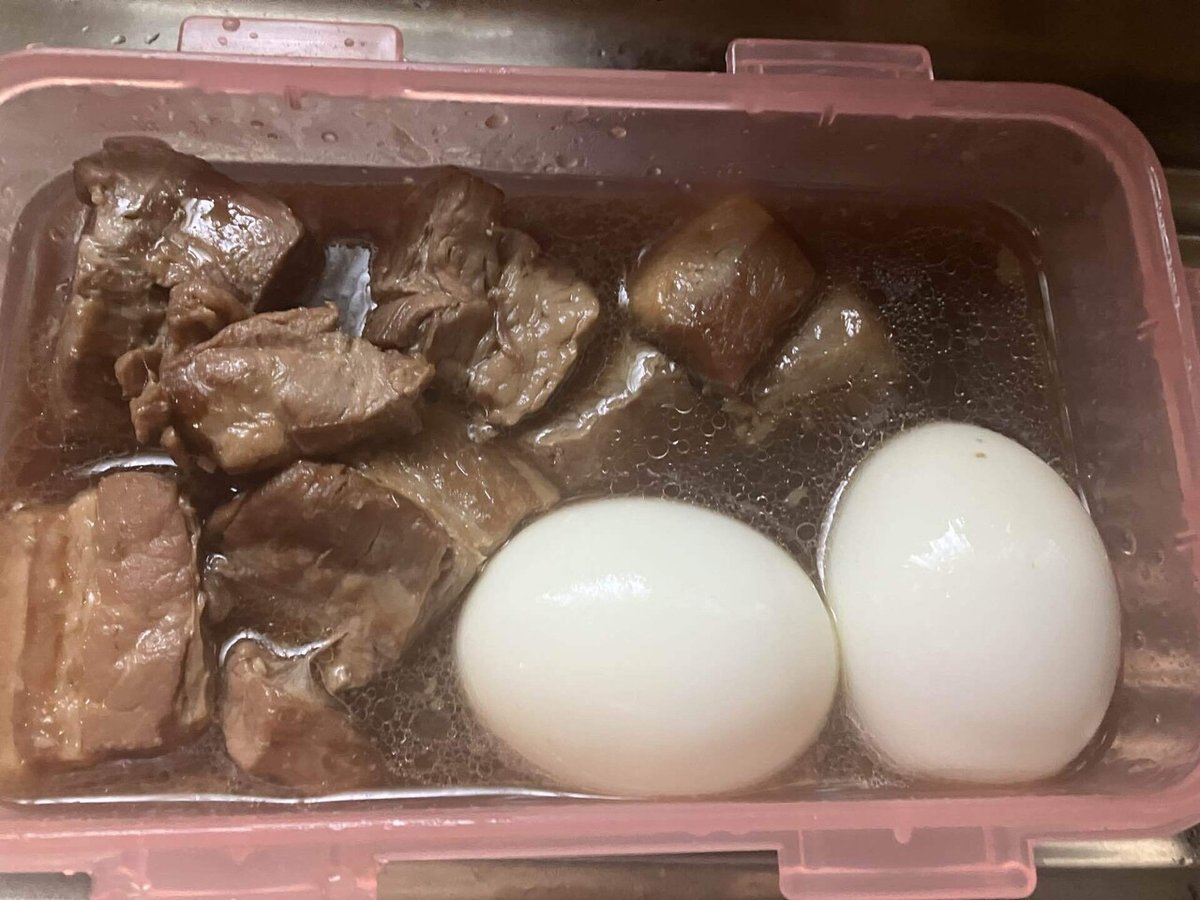
(マー油を作る)
長ネギとニンニクを、調理の直前にみじん切りにする。
角煮を作るときに分離したラードをフライパンか中華鍋に入れ、弱めの中火で加熱する。
ネギとニンニクそれぞれの1/3量をフライパンに入れ、揚げる。
材料が薄い茶色に色づいたら、また1/3を入れ、同じように揚げる。
残りの材料を全て入れ、また同じように揚げ、火を止める。
この時点で、3段階の焦げ方の材料が共存することになる。
ラードが冷えたら、すり鉢か小型のミキサーなどで、脂と素材を細かくすり潰す。
このマー油は1ヶ月以上常温での保管が可能。
(Making garlic oil)
Finely chop the spring onions and garlic just before cooking.
Put the lard separated when making the braised pork into a frying pan or wok and heat over low-medium heat.
Add 1/3 of the spring onions and garlic to the frying pan and fry.
Once the ingredients have turned light brown, add another 1/3 and fry in the same way.
Add the remaining ingredients, fry in the same way, then turn off the heat.
At this point, you will have three ingredients that will brown in three different ways.
Once the lard has cooled, finely grind the fat and ingredients in a mortar and pestle or small blender.
This garlic oil can be stored at room temperature for over a month.


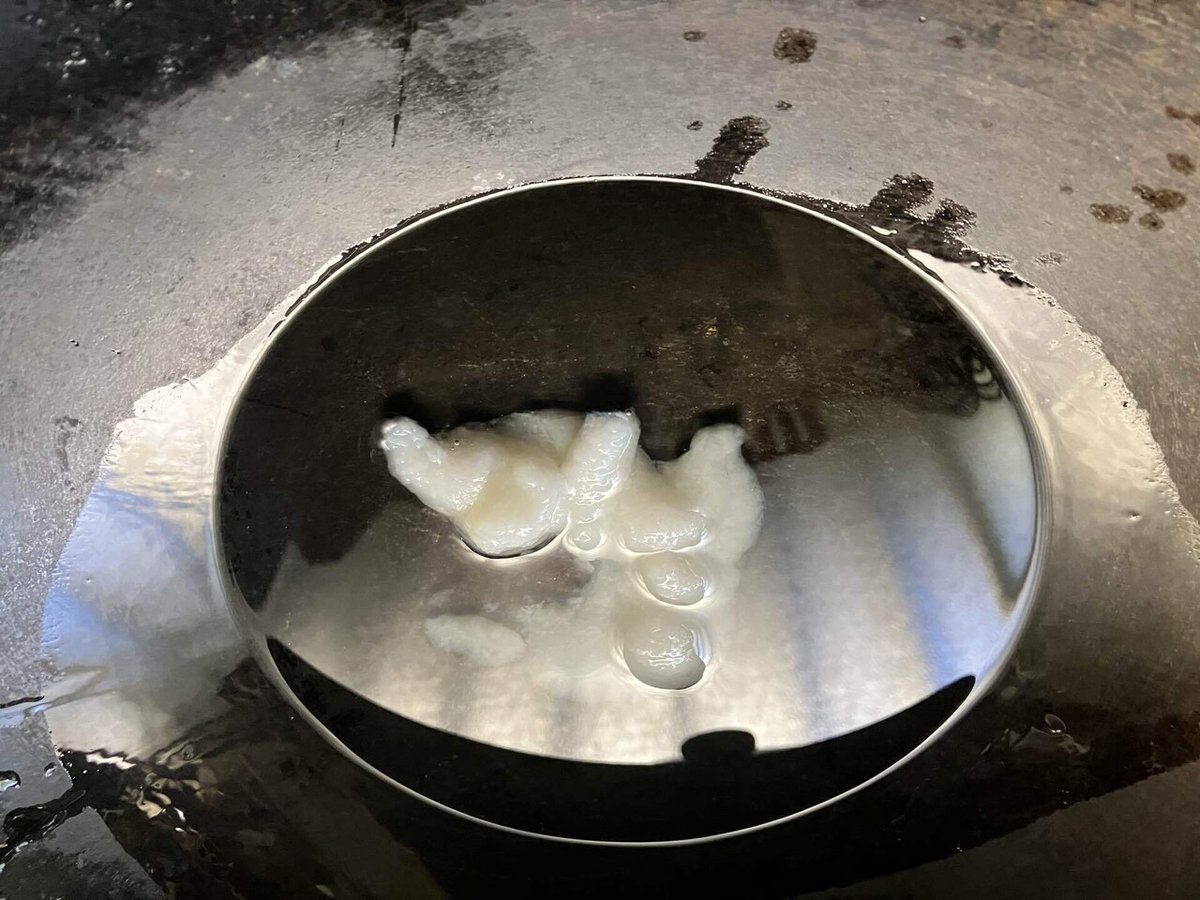








(メンマと茎わかめを煮る)
メンマは一晩水に浸けて塩抜きしておく。水煮メンマなら、塩抜きは不要。
茎わかめも一晩塩抜きをしておく。生なら塩抜きは不要。
角煮の煮汁の一部を鍋に入れ水を注ぎ、醤油で少し味を補っておく。
そこに塩抜きしたメンマを入れ、十分ほど煮て、煮汁ごと冷まして、出来上がったメンマを取り出す。
残った煮汁に酢を加え、塩抜きした茎わかめを入れて、十分ほど煮て、煮汁ごと冷ます。
これらの煮物は、冷蔵庫で5日ほど保存可能で、他の用途にも使えるので、前もって、角煮と一緒にまとめて作っておいても良い。
(Cooking menma and wakame stems)
Soak menma in water overnight to remove salt. If you are using menma in water, there is no need to remove salt.
Soak wakame stems overnight to remove salt as well. If they are raw, there is no need to remove salt.
Put some of the broth from the braised pork into a pot, pour in water, and add a little soy sauce to add flavor.
Add the desalted menma, boil for about 10 minutes, cool the broth, and remove the finished menma.
Add vinegar to the remaining broth, add the desalted wakame stems, boil for about 10 minutes, and cool the broth.
These simmered dishes can be stored in the refrigerator for about 5 days and can be used for other purposes, so you can make them in advance together with the braised pork.
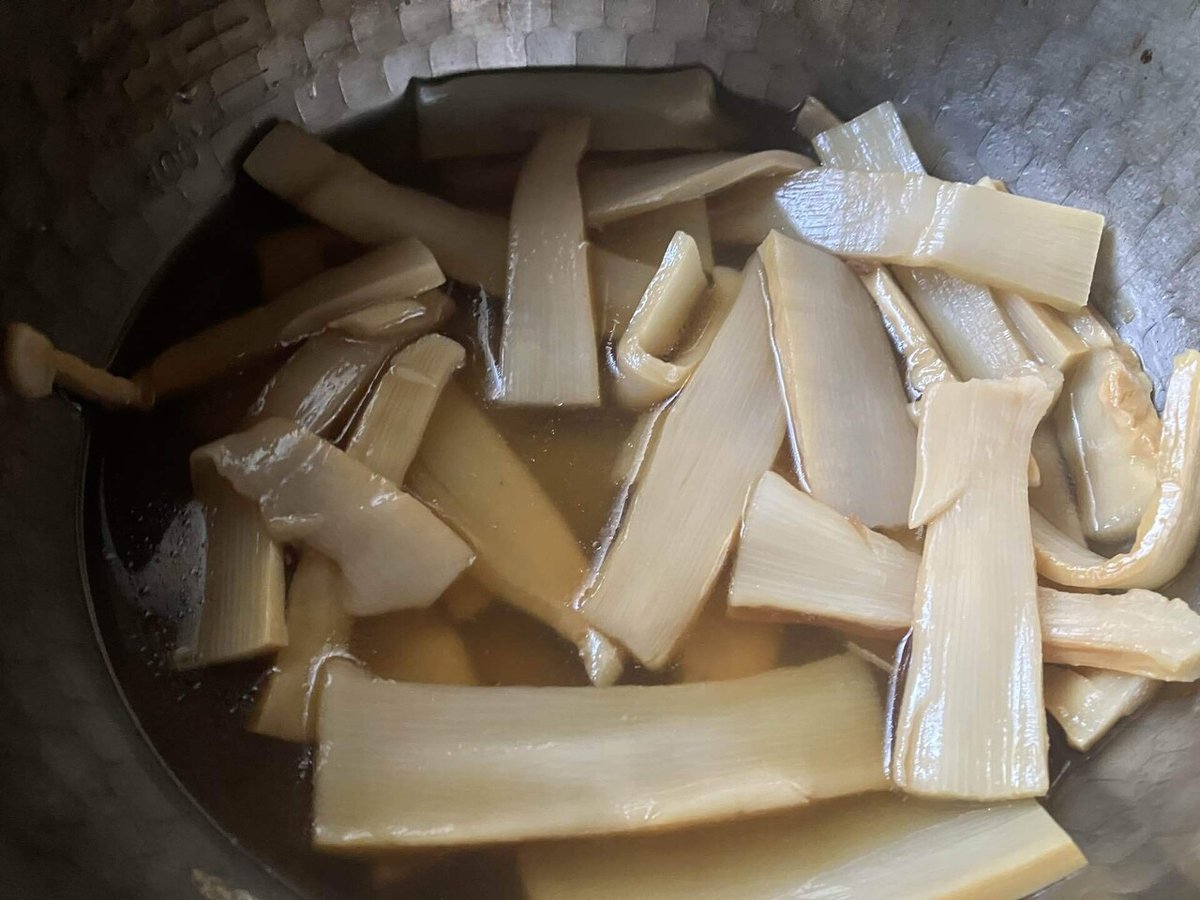
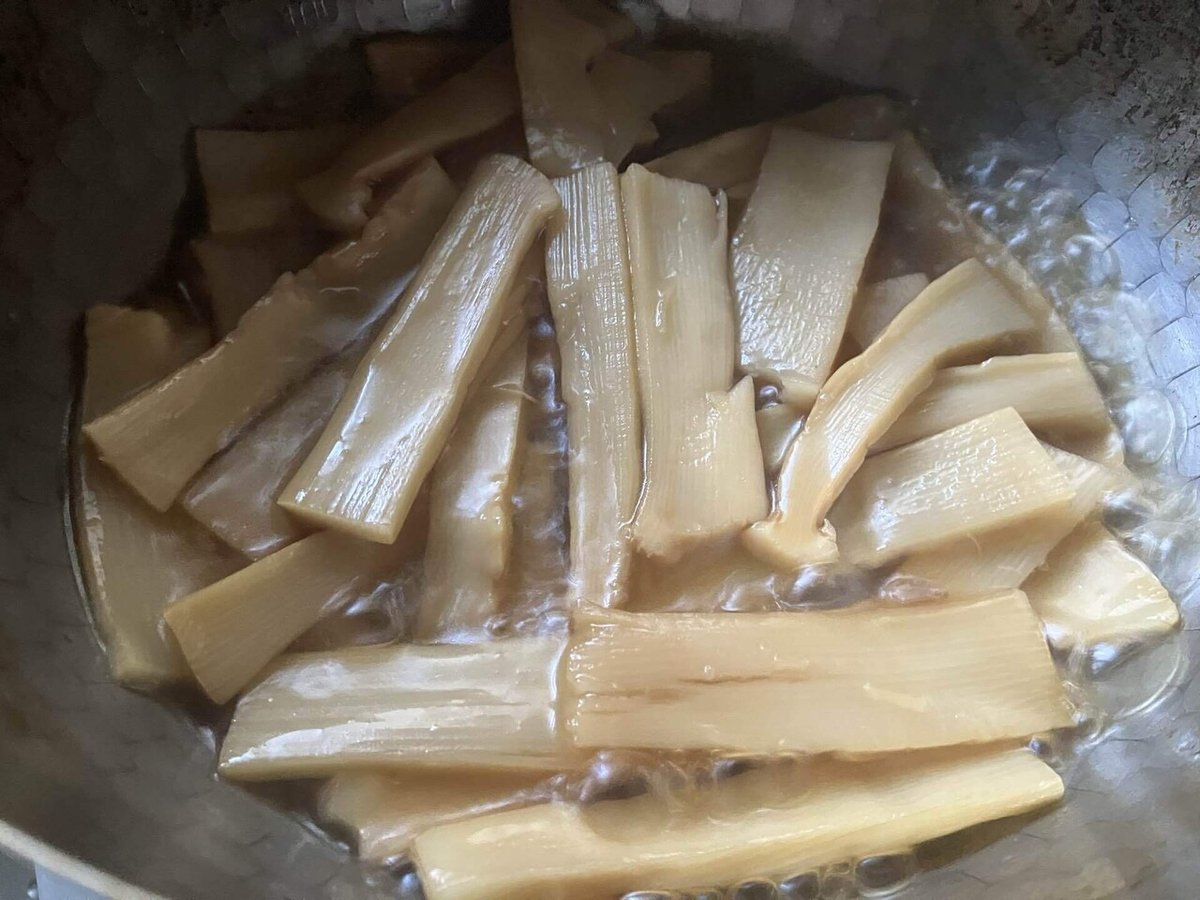


(ラーメンスープを作る)
手羽元を鍋に入れ(一人前一本)、水をたっぷり注いで、一時間以上茹でる。圧力鍋を使うと、15分に短縮できる。ここでは、取った鶏出汁のみを使う。
取った出汁は、鍋ごと急冷して冷蔵庫に入れておけば、4日ほど保存が可能。肉は他に応用可能。
鍋に豚足を入れ(二人前一本)、たっぷりの水を注いで、二時間以上茹でる。圧力鍋を使えば、40分に短縮できる。
煮崩れたところで、骨を取り出して布巾で包み、金槌などで叩き割って、鍋に戻す。
蓋をしないで、強火でぐらぐら煮立てながら、骨の中の髄を、白濁するまで、よく煮汁に溶け出させる。
取った出汁は、鍋ごと急冷して冷蔵庫に入れておけば、4日ほど保存が可能。
(Making ramen soup)
Put chicken wings into a pot (one for one person), pour in plenty of water, and boil for at least an hour. If you use a pressure cooker, you can shorten the time to 15 minutes. Here, only use the reserved chicken stock.
The reserved stock can be stored for about four days if you quickly cool the pot and put it in the refrigerator. The meat can be used for other purposes.
Put pork trotters into a pot (one for two people), pour in plenty of water, and boil for at least two hours. If you use a pressure cooker, you can shorten the time to 40 minutes.
When the bones have fallen apart, remove them, wrap them in a cloth, smash them with a hammer, and return them to the pot.
Bring the mixture to a rolling boil over high heat without a lid, allowing the marrow inside the bones to dissolve into the broth until it becomes cloudy.
The reserved stock can be stored for about four days if you quickly cool the pot and put it in the refrigerator.






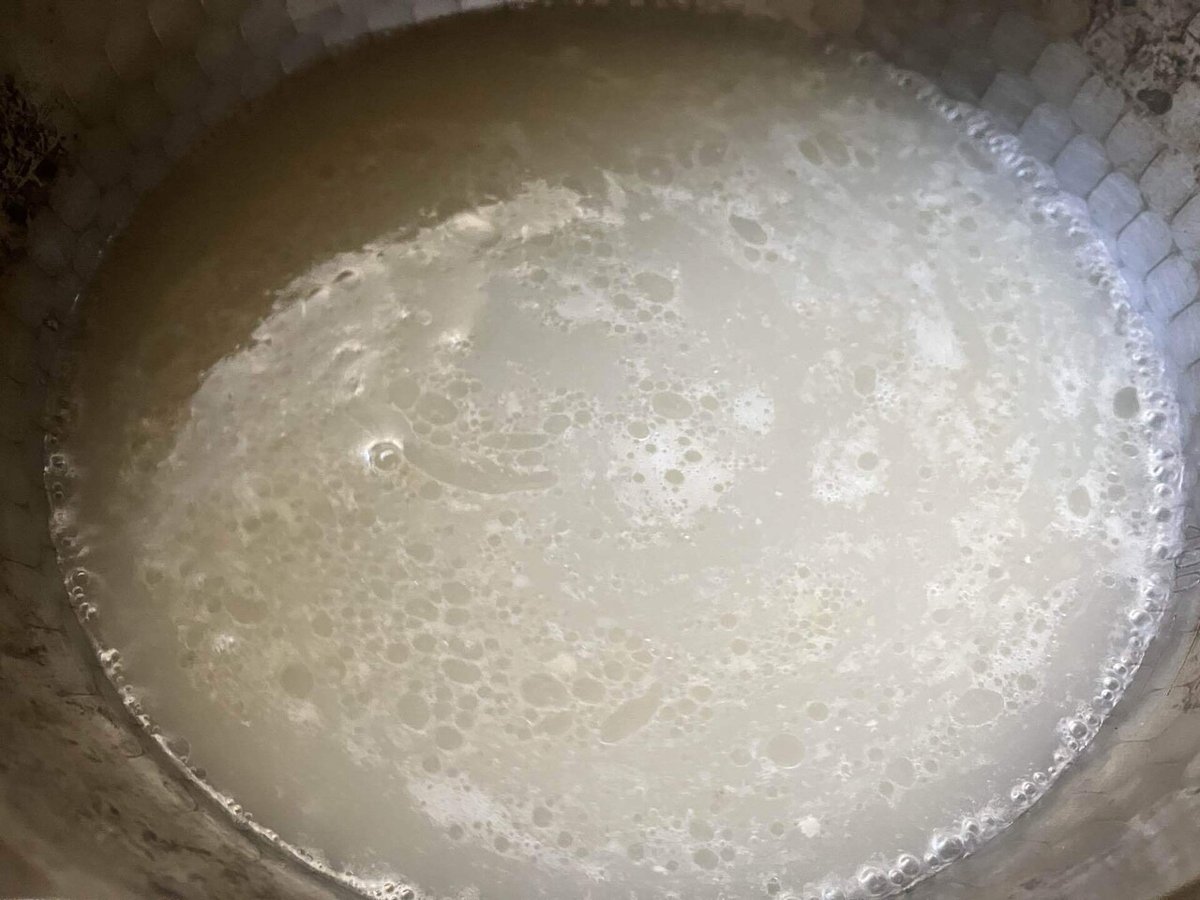
(太肉麺を作る)
鍋に、前節で作った、豚バラ肉の茹で汁、鶏手羽の出汁、白濁した豚足の出汁をブレンドして入れ、加熱し、自然塩で味付けをしておく。
キャベツはざく切りにし、博多ネギは小口に刻んでおく。
煮卵は半分に割っておく。
豚の角煮は、グリルかオーブントースターで焦げ目をつけておく。
鍋にお湯を沸かして、乾麺を茹でる。
麺の茹で汁で丼を温めて、茹で汁を捨てる。
温まった丼に、豚の角煮の煮汁を少し入れ、温めておいたラーメンスープを注ぎ、よく混ぜる。
茹だった乾麺を入れ、具材(キャベツ、角煮、メンマ、茎わかめ、博多ネギ)をトッピングする。
マー油もトッピングする。
(Making taaroo noodles)
Blend the pork belly broth, chicken wing broth, and cloudy pork trotter broth made in the previous step into a pot, heat, and season with sea salt.
Roughly chop the cabbage and finely chop the Hakata leek.
Cut the cooked eggs in half.
Brown the braised pork on the grill or in a toaster oven.
Bring water to a boil in a pot and boil the dried noodles.
Warm a bowl with the noodle water and discard the water.
Add a little of the braised pork broth to the warm bowl, pour in the heated ramen soup, and mix well.
Add the boiled dried noodles and top with the ingredients (cabbage, braised pork, menma, stem wakame, Hakata leek).
Top with garlic oil as well.


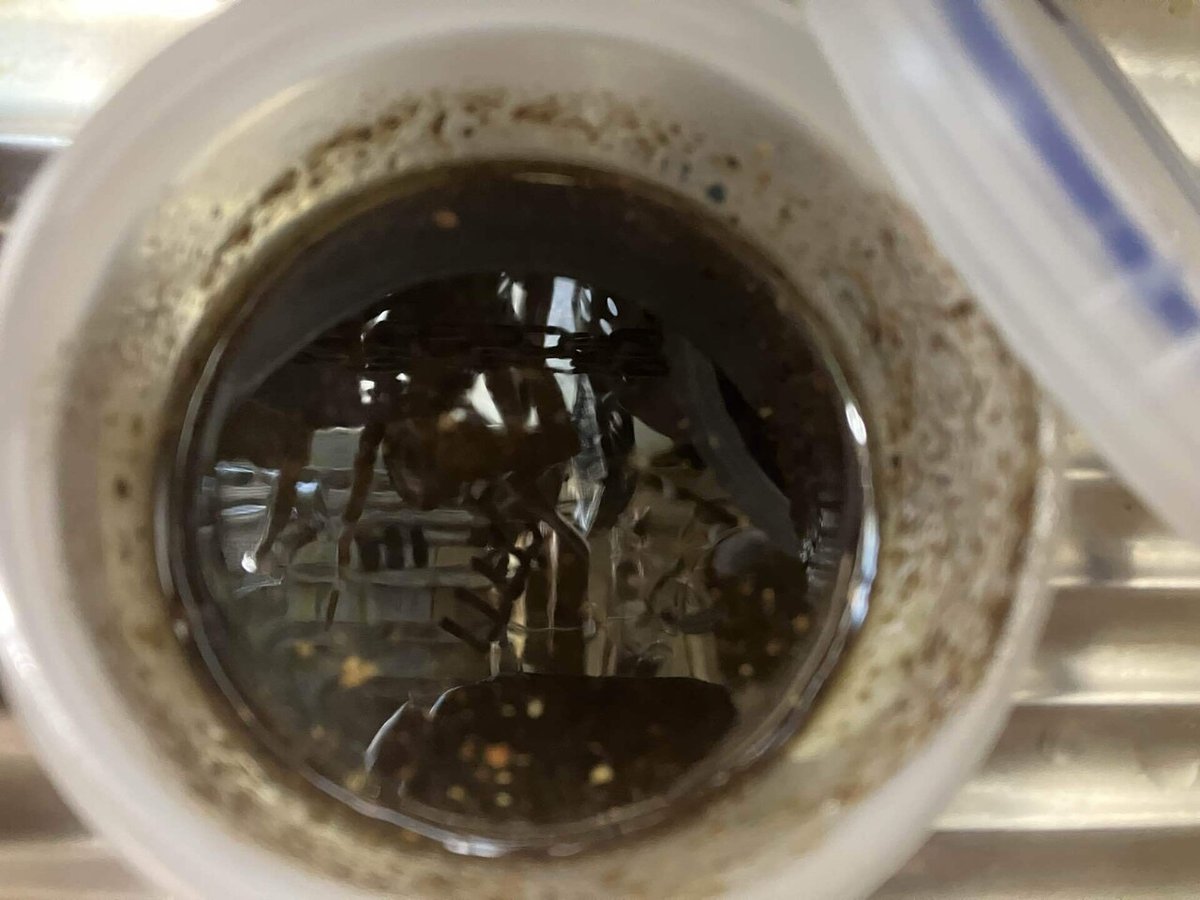








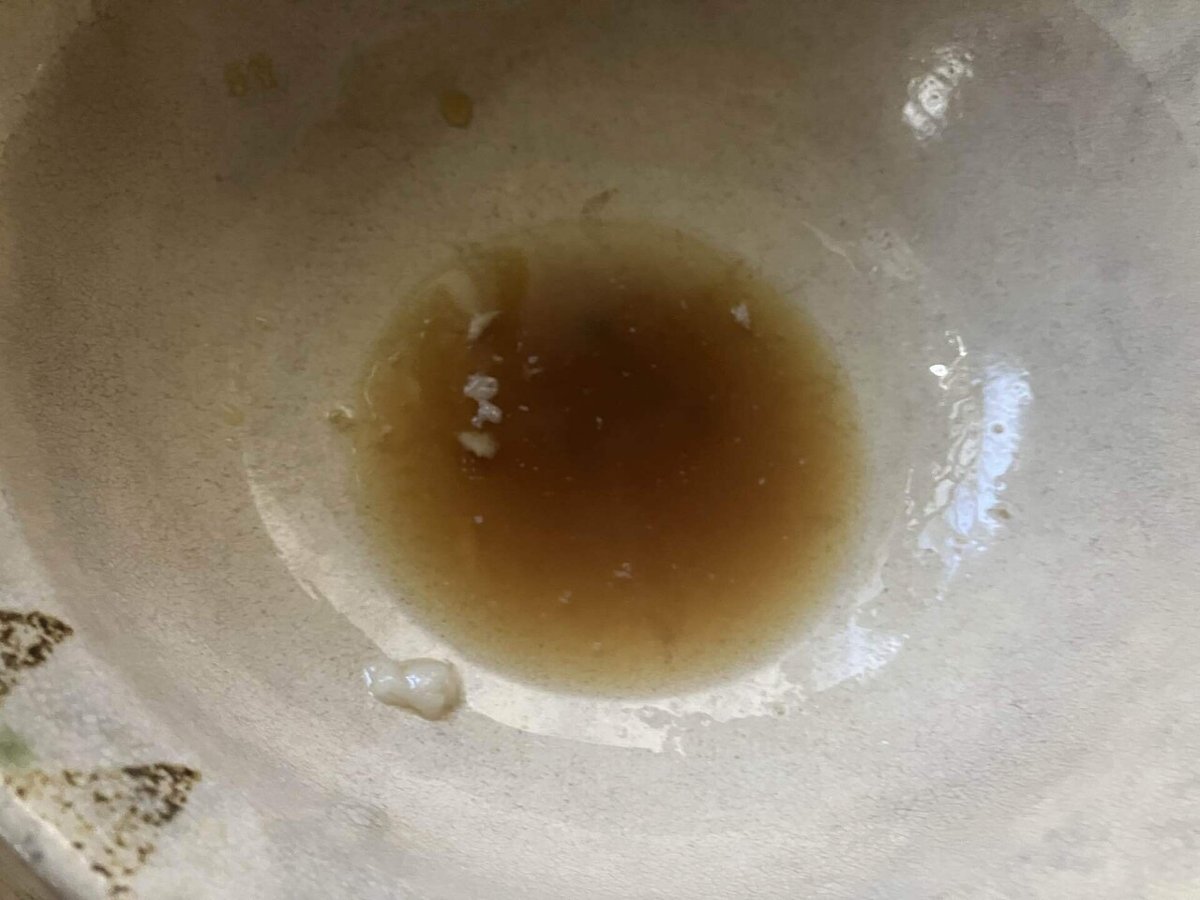





Tips and tricks:
コツと応用のヒント:
随分と、面倒な手間だが、習作と考えれば、良い練習になり、いろいろな応用が考えられる。ラーメンマニアなら、豚骨系ラーメンの味の分析や再現の良い課となる。何らかのヒントになれば。市販品や有名レストランの味を再現するのは、非常に良い料理の勉強になる。
It's a lot of work, but if you think of it as a study, it's good practice and can be applied in many ways. Also, if you're a ramen fanatic, it's a good challenge to analyze and reproduce the taste of tonkotsu ramen. I hope it will give you some hints. Recreating the flavors of commercially available products or famous restaurants is a great way to learn cooking.
豚の角煮については、以前の沖縄そばの記事で詳しく触れているので、よければ参考にしてほしい。沖縄そばに使うラフテーの鰹節を除き、泡盛を焼酎に帰れば、工程はほぼ一緒だ。
I have covered the braised pork in detail in my previous article on Okinawa soba, so please feel free to refer to it. With the exception of the bonito flakes used in Okinawa soba and the awamori being converted into shochu, the process is almost the same.
マー油は、熊本ラーメンを特徴づける調味料。ここではニンニクとネギを使ったが、他にも、香味野菜である、玉ねぎ、セロリ、人参、パセリなどを使っても良い。幾つかの異なった焦し具合の素材ををブレンドするところに妙味がある。素材の割合や、焦がし方、ブレンドの比率を変えると、香りが変化するので、自分のオリジナルを追求しても良い。手作りのラー油やスパイスオイルなどとブレンドしても、新しい味が作り出せる。
Maayu(garlic oil) is a seasoning that characterizes Kumamoto ramen. Garlic and green onions are used here, but other aromatic vegetables such as onion, celery, carrot, and parsley can also be used. The secret is in blending ingredients with different toasting levels. Changing the ratio of ingredients, the toasting method, and the blend ratio will change the aroma, so you can pursue your own original flavor. You can also create new flavors by blending it with homemade chili oil or spice oil.
スープは、豚バラ肉の茹で汁、鶏手羽元の出汁、豚足で作った白濁の出汁の3種類をブレンドして作った。豚骨や豚頭骨は個人では調達しにくいので、手に入りやすい豚足で代用している。途中で骨を割って煮立たせるのがポイント。豚足のゼラチン質と骨の髄が溶け出して、良い白濁した豚スープが取れる。
鶏ガラが手に入るなら、それでも良い。ただ、ここでやったように、鶏手羽元でも代用できる。余った肉は、サラダや中華の具などに応用できるので、無駄はない。
圧力鍋は必須ではないが、あると、相当な時間の短縮になる。その場合、茹でたり蒸したりする工程は圧力鍋の機能を使い、煮含める工程では、蓋を外して、厚底鍋として使うと、全体の調理時間を最短できる。
また、スープを作ったり、煮物をした場合、鍋ごと大きなボウルに沈めて、氷や保冷剤で急冷すると、冷蔵庫での保存期間が倍以上に伸びる。この素材の運用は、業務用の調理知識の応用。後に、ケータリング商売をしたり、自分のお店を持つことを考えているのなら、作った素材をすぐに急冷する習慣をつけておくと良い。食中毒リスクや破棄率を飛躍的に減らすことができる。
The soup is made by blending three types of soup stock: boiled pork belly water, chicken wing stock, and cloudy pork trotters. Pork bones and pig heads are difficult for individuals to obtain, so I used pig trotters, which are easy to get. The key is to break the bones halfway through the process and bring it to a boil. The gelatin in the trotters and the marrow in the bones will dissolve and produce a good cloudy pork soup.
If you can get chicken bones, that's fine too. However, as I did here, you can also use chicken wings instead. The leftover meat can be used in salads and Chinese ingredients, so nothing goes to waste.
A pressure cooker is not essential, but having one will save you a lot of time. In that case, use the pressure cooker function for the boiling and steaming process, and remove the lid and use it as a thick-bottomed pot for the stewing process to minimize the overall cooking time.
Also, if you make soup or stew, submerging the pot in a large bowl and quickly cooling it with ice or ice packs will more than double the shelf life in the refrigerator. This method of using ingredients is an application of commercial cooking knowledge. If you are thinking of doing catering or opening your own restaurant later, it is a good idea to get into the habit of cooling ingredients as soon as you make them. This will drastically reduce the risk of food poisoning and the rate of waste.
ラーメンを作る時は、高級店でない場合は、材料が無駄にならないように素材を使い切ることが大切。角煮の茹で汁やラードを次の工程で使っているのも、その一環。角煮の煮汁をラーメンのタレに使ったり、そのタレを使って、メンマや茎わかめを煮ているのは、そういった工夫の一つ。茎わかめを煮るときにお酢を入れているのは、味の変化のためと、茎わかめを柔らかくするため。
When making ramen, unless you are at a high-end restaurant, it is important to use up all the ingredients so that they do not go to waste. Using the broth from the braised pork and lard in the next process is one example of this. Using the broth from the braised pork as the ramen sauce, and using that sauce to boil bamboo shoots and wakame seaweed, is one example of this. Vinegar is added when boiling the wakame seaweed to change the flavor and to soften the seaweed.
Guide to where to get ingredients and equipment 材料と機材の入手先ガイド
※Amazonのアフェリエイトに参加しています。もしご購入の際はここからクリックしてご購入いただけると、コーヒー代の足しになるので、嬉しいです。ちなみに僕はコーヒー依存症です。
*I participate in Amazon affiliate programs. If you purchase this product by clicking here, it will help pay for my coffee, so I would be verhy happy. By the way, I am addicted to coffee.
